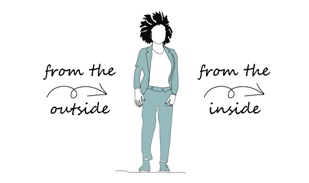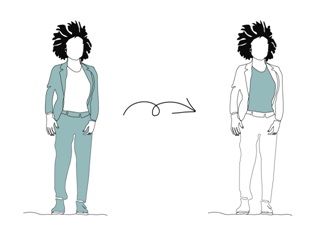A Coaching Model By Debora Hofmann, Leadership Coach, GERMANY
Your Unique Story
I was fascinated with Coaching since I was about 22 years. And when I stumbled across the idea that you can use the principles of good storytelling to craft your life in the same way a good author is crafting a story, it was the same fascination.
In my coaching model, I’m combining the two perspectives.
Personally, what I am finding so compelling about coaching is the idea that the client is seen as resourceful and capable. This perspective is fundamentally different than a therapeutic or consulting approach. As a Coach, I love that I don’t have the answers but I am discovering those answers together with my clients.
The idea of “storytelling with our lives” became important for me for other reasons: Through the years that I studied sociology, I got deeply used to thinking in systems and seeing anyone as a carrier of different roles in different plays that need to be performed. Inter- and Intra role conflicts are my daily jam. My head is constantly dissecting systems and conflicts around me. Using the storytelling approach I can let go of purely analytical thinking and start to focus on the future. What is supposed to be happening here? Where is all this meant to be going?
This was highly helpful for me and I hope it will serve my future clients as well.
Elements of Storytelling Approach
Here are the most important aspects of storytelling, how they relate to “storytelling with our lives” and how Coaching looks like when we see it through the lens of storytelling.
There Is a Heroine[1]
 … in storytelling:
… in storytelling:
Each story needs a Heroine that has to experience something.
Really important is the fact, that they are not naturally strong, achieving personalities. They evolve into this throughout the story.
“In Stories, heroes are weak characters becoming strong.” (Miller 2021, 100)
… in our own life:
If I think about myself as the heroine of my life (or even clearer: my life story) I have to ask deep and meaningful questions:
What is my heroine’s story supposed to be about? What is my purpose as a heroine? Whom am I supposed to serve?
… in Coaching:
In Coaching our clients are the heroines of their life stories. Our job as Coaches is to come alongside them as their guides. As guides, we know what questions to ask, so that our clients start to see themselves as Heroines in their stories and can move forward. As we are trained to see them as resourceful and capable anyways, seeing them as the heroines in their story comes easy and natural for us.
An Inciting Incident Needs to Happen
 … in storytelling:
… in storytelling:
Something needs to happen in a story, for the story to move forward. Someone is made redundant, a ring is bought (or not), a phone call with a promotion comes in, someone is sent into a foreign country as an ex-pat. The inciting incident in a story brings with it some form of task, that the heroine needs to accomplish.
… in our own life:
In our lives as well as in any story inciting incidents can come from the outside as something happening to us, but it can also be the little voice inside of us. Our voice may call us into a new adventure or our truth or even just rest. The inciting incident is when we are finally willing to listen to this voice and follow up on it.
… in Coaching:
In Coaching, on the one hand, our clients usually come to us, because they just experienced an inciting incident. Something has changed and now they want to support it.
On the other hand, an inciting incident is also the action step at the end of a coaching session. We want our clients to get good at making inciting incidents happen for themselves (aka in their own story) and in the systems, they live in (aka in the stories of others).
A Character Transformation of the Heroine Needs to Take Place
 … in storytelling:
… in storytelling:
After an inciting incident, there is always a need for a character transformation of the heroine. For her to achieve the task the inciting incident put on her, she has to change somehow, leave something behind, learn something new. It is highly entertaining to watch this process on a screen when it is well done.
… in our own life:
Having to go through a necessary character transformation in our real lives is much harder, much more draining, much more uncertain. We usually don’t like this process because change is always deep emotional work.
… in Coaching:
Our clients always come to us with the need for character transformation, because something is not working out anymore. It is a great privilege to walk next to them for a little while as their guides and witness from the front line how they do the hard work of learning. While taking one step after the other with our continuous support right next to them, they slowly transform into a new characters.
The Heroine Needs to Overcome Fear & Conflicts
 … in storytelling:
… in storytelling:
Heroines always need to overcome some sort of either fear or conflict for a story to be interesting. Those conflicts might be with a boss, the partner, parents, and quite often even just within the heroine herself.
… in our own life:
Depending on our personality we have very different ways to handle our fears and conflicts, but one thing is for sure: We all have fears and conflicts at work in our life and the clearer we see them, the easier we will find our way to transform our character.
When we as Coaches do our work of character transformation and facing our fears and conflicts upfront, we will also find it easier to support our Clients in this work.
… in Coaching:
In Coaching, fears can show up as limiting beliefs, that need to be addressed. Limiting beliefs are the stories that clients tell themselves about certain situations or persons. They need support in overcoming those limiting stories and find new, more empowering stories to hold onto.
Conflicts always arise within systems, either within the client or between the clients and other people, organizations, etc. System thinking is therefore a key element for a coach to help a client move forward.
Why the Lens of Storytelling Is Helping?
In the over-individualized western hemisphere, we tend to think of ourselves way too much as individual beings that exist just for ourselves. Anything that happens in our lives is because we either made it happen or we missed taking care of it beforehand. Each of us is responsible for the life we live and blame and guilt kick in quite often when we think about our achievements or missed opportunities.
Thinking about ourselves as characters in a story puts a playful element into this perspective. If we think about ourselves as heroines in a story, it comes with no surprise that f.e. conflict will show up at some point in our life. Conflict makes the story interesting and drives change and development. Conflict doesn’t exist because we’ve done something wrong but because it has to be there. It is necessary. With this perspective blame and shame is not interesting anymore, instead, we can focus on how to move forward and make the necessary changes happen.
Unique Stories of Young Female Leaders
Young female leaders in organizations find themselves confronted with a lot of expectations:
- Their bosses and CEOs have an idea of how they are supposed to show up and do the work.
- Their team has strong pictures in mind on how their leadership style should look and feel.
- Their parents, partners, and friends have expectations.
- If they decide to become mothers, there is a whole layer of expectations added on top of that.
All this is happening in a highly agile world, where change is a constant, while old patriotic systems are still at work (Nagoski 2019).
In this environment, it is impossible to satisfy all the expectations that are posed on young female leaders.
Through the lens of storytelling, a young female leader gets a sense of distance between herself and those expectations. She can start to see herself as the heroine of a fascinating story in which she is evolving and learning. The obstacles that she finds in her way are necessary to move her forward. She can name which inciting incidents are at play at a certain moment. She gets to choose what she wants her story to be about, where she wants it to go, what character change she wants to see in herself, and which of her fears she wants to work on. She can analyze what kind of environment her character has to cope with and if she, the heroine of this story, wants to stay there. Maybe her heart is calling her somewhere totally different?
She can decide what kind of heroine she wants to be as a leader, what are her values and goals, how she wants to influence people, and what she is fighting for.
With that in mind, the storytelling approach is first and foremost designed to empower the Heroine within every young female leader.
References
Miller, Donald: Business Made Simple. 60 Days to Master Leadership, Sales, Marketing, Execution, Management, Personal Productivity, and More
Miller, Donald: A Million Miles in a Thousand Years: How I Learned to Live a Better Story
Nagoski, Emily & Amelia: Burnout. Solve Your Stress Cycle
[1] Since I am planning to work with young female leaders, I will stick to Heroine in this work.
